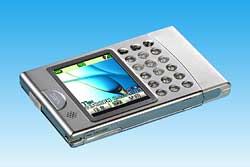Kids Web Japan
Web Japan > Kids Web Japan > Hi-tech > Mobile Phones > The Future of Mobile Phones
Hi-tech
Mobile Phones
The Future of Mobile Phones

A mobile phone not much bigger than a credit card (NEC Corp.)
The year 2003 saw the full-fledged appearance of what have been called third-generation mobile phones. The rate of data transfer is more than 100 times faster than that of second-generation units, making it possible, for example, to send and receive TV-quality images. There are now even some mobile phones that can receive actual TV broadcasts. And because a high-speed Internet connection is possible, the fusion of mobile phones with personal computers is moving ahead. Base stations need to be upgraded, however, to facilitate the use of third-generation phones, and it is expected that third-generation units will not become dominant until 2005 or 2006 at the earliest.
So what kinds of mobile phones will appear in Japan in the future? Many people expect that phones will continue to become smaller and predict the arrival of models that can be worn as a wristwatch or pendant. Japanese makers only account for a little over 10% of the global market for mobile phones, which is around 500 million units annually. Japanese companies are looking to increase this share, and in order to do so they are working hard to make models more compact - a Japanese strength - and to develop new technology for batteries.
These days, more and more home appliances are becoming digitized. It may soon become possible for people to program their VCRs while away from home and to set their air conditioners to switch on shortly before they return. Many people believe that mobile phones will eventually become a sort of all-purpose remote control.